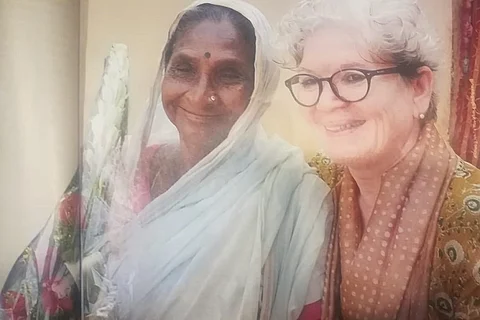

Sarah Joseph got the phone number of Vijayakumar, PRO of the Damodar Valley Corporation, after a lot of trouble. She was writing a novel on Budhni, a woman who was thought to be dead, decades after she was banned by the Santhal tribe in Jharkhand. Budhni had garlanded Prime Minister Jawaharlal Nehru, who came to inaugurate the Panchet dam in Damodar Valley in 1959. She was 15 then and working with the Damodar Valley Corporation. Her action had been against the traditions of the tribe, which considered the act of garlanding a marriage. She was thrown out of her home and village for marrying outside the community and dubbed by the media as the ‘tribal wife of Nehru’.
Writer Sarah Joseph called Vijayakumar when she wanted to visit Budhni’s village and meet people who could tell her about Budhni. Vijayakumar, on the phone, asked her: “Why don’t you ask all your questions to Budhni herself?”
Sarah was shocked. She made sure they were both speaking of the same person. “If you are asking about the woman who was ousted from her village for putting a garland on Nehru, she is still alive,” Vijayakumar said.
“It was a big shock to me. I had read an article in The Hindu, ‘Recovering Budhni Mehjan from the silted landscape of modern India’, that appeared on June 2, 2012. It said that Budhni died in 2010,” Sarah tells TNM on a call.
Sarah wrote about meeting Budhni in the Mathrubhumi magazine – the same one that published her novel Budhni as a series. “I was very happy to meet her. She didn’t have much to say though. I asked her if she wanted to go back, but she has now put her past behind her. She said what’s over is over. She didn’t even want to talk about it,” Sarah says.
Budhni with Jawaharlal Nehru at the Panchet Dam inauguration in 1959; Courtesy: The Hindu
It is years earlier that Sarah heard Budhni’s story in a speech by writer and political critic Civic Chandran. She says, “I had been part of the protests against the Athirappilly (hydroelectric) project. Many studies had proved it is without scope. In one such gathering, Civic Chandran spoke about Budhni. It touched me so much.”
Sarah went back and read more and more about Budhni. “I realised it cannot be a short story or essay. There were so many aspects to Budhni’s story – India’s history, India’s development history, so many different roots. It took me one-and-a-half years of preparations. We didn’t know anything about this girl from the Santhal tribe. What is her life, her history, language, culture?”
When she delved deep, Sarah began reading about the losses that the development of the country at various stages has often resulted in. She is talking about the people who were evicted from their homes. “Different studies suggest that about six-and-a-half crore people were evicted from their own land since 1947. How has the government concern been in this case – has a method been formed in independent India? At the time of the British rule land acquisition was easy. They would beat up and throw people out their homes and take over the land. But what about independent India? For many big projects, land has been taken over. What happens to the people who are evicted from these lands? The political sculptors may envision a project for them, but it should be implemented. About seven or eight thousand families were evicted for this Panchet dam project. Where did they go… so many aspects would evolve from Budhni’s story.”
Once she wrote two chapters of her novel Budhni, she wanted to visit her village in Jharkhand. Discovering Budhni had made her very happy, Sarah says. “Budhni is planning to visit Kerala for the book launch in Kozhikode next month.”